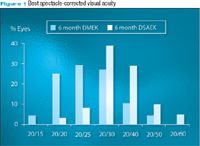Article
Descemet's membrane endothelial keratoplasty series highlights pros, cons
A newer form of endothelial keratoplasty - DMEK - provides better visual and refractive outcomes compared with Descemet's stripping automated endothelial keratoplasty.
Indianapolis-A newer form of endothelial keratoplasty-Descemet's membrane endothelial keratoplasty (DMEK)-provides better visual and refractive outcomes compared with Descemet's stripping automated endothelial keratoplasty (DSAEK), according to data from 1 year of follow-up in a prospective study of an initial consecutive cohort of 65 eyes, said Marianne O. Price, PhD.
DMEK was first introduced by Dutch ophthalmologist Gerrit Melles, MD, PhD, and uses a donor lenticule that contains only Descemet's membrane and endothelium.
Dr. Price, executive director, Cornea Research Foundation of America, Indianapolis, presented results from 1 year of follow-up from a series of 60 eyes operated on by a single surgeon, Francis W. Price Jr., MD, medical director, Price Vision Group, Indianapolis, and of the Cornea Research Foundation of America.
The vision benefit of DMEK was achieved with endothelial cell loss rates that are similar to those associated with DSAEK. However, difficulties were encountered during DMEK donor preparation and the primary graft failure rate was higher in the series of DMEK eyes versus after DSAEK, Dr. Marianne Price said.
"DSEK/DSAEK is currently considered the preferred graft procedure for eyes with endothelial dysfunction," she said. "However, rates of 20/20 BSCVA after DSAEK have been less than expected relative to visual potential. For example, in our initial DSAEK eyes, the majority had visual acuity of just 20/30 to 20/40 at 6 months."
DMEK limits refractive surprises and offers improved visual outcome because the donor material is devoid of stroma. Therefore, it has more uniform thickness and contour and avoids problems with macro- and microfolds that can limit vision, she explained.
"In addition, the incision for inserting the DMEK donor is smaller, 2.8- or 3-mm incision, which improves the predictability of astigmatism management," she said. "Nevertheless, donor preparation and attachment are more challenging with DMEK, although we are pleased that DMEK donor preparation is now available from several U.S. eye banks, including the Indiana Lions Eye and Tissue Transplant Bank and the Iowa Lions Eye Bank."

The patients in the series had a mean age of 67 years, and 58 of the 60 eyes had a diagnosis of Fuchs' dystrophy. In 17% of cases, DMEK was combined with cataract surgery.





